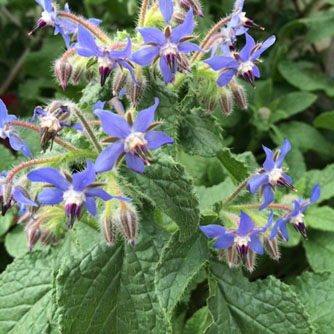Borage
Back
Borage (Borago officinalis) with its blue, starry flowers and hairy foliage is a lovely addition to any garden or herb patch. Young leaves can be used in soups and stews or mixed into salads to add a crisp, cucumber flavour. The flowers are edible as well and make a great garnish for salads or dips. Try freezing them in ice cubes for your next garden party drinks!
The blue flowers are irresistible to bees so plant next to fruit trees and in your veggie patch to improve pollination and yields. Occasionally plants will produce a few pink flowers and there is also a stable white variety available (B. officinalis ‘Alba’) which flowers slightly later than the blue form.
How To Grow Borage
Borage is an annual that is adaptable to most soils and situations and grows easily from seed. If your soil is very poor however work in some manure or compost beforehand. In heavy clay apply some gypsum too.
Sow seed either directly into the soil in a sunny position or in pots filled with a premium potting mix. Water in with OCP eco-seaweed to enhance germination and expect to see seedlings emerge in 5-10 days. Mulch around plants to conserve soil moisture.
Borage grows to about 80cm high and will self seed readily each year.

The star-shaped borage flowers sit above the foliage
Sowing Guide for Borage
| Growing Zone | Sowing Time |
| Cool Zone | Spring, Summer |
| Mediterranean Zones | Spring, Summer, Autumn |
| Warm & Temperate Frost Free Zones | Spring, Summer, Autumn, Winter |
| Tropical & Subtropical Zones | Spring, Summer, Autumn, Winter |
Borage is frost sensitive so the above timings may need to be tweaked according to your local conditions.
Fertilising & Harvesting Borage
When plants are young apply a mix of OCP eco-seaweed and OCP eco-aminogro every two weeks to promote strong and vigorous growth. Once established this can be reduced to every 3-4 weeks.
Borage plants are covered in fine hairs and it’s best to only pick young leaves while the hairs are still soft. The texture of older leaves feels very funny in the mouth and is not enjoyable. Wash picked leaves and shred before adding to soups, stews or salads. Leaves and flowers can also be used in summer drinks or infused as a herbal tea.

Bees can't get enough of the delicious nectar in borage flowers
Pests and Diseases of Borage
Usually borage is trouble free to grow but here are a few problems which occasionally occur:
- Snails – mostly only a problem to newly planted out seedlings. Protect with OCP eco-shield.
- Caterpillars – pick off any that you spot or spray with OCP eco-caterpillar killer.
- Powdery mildew – more common on plants grown in too much shade but if necessary spray with an organic fungicide.
- Sap suckers like aphids, mites and whitefly - spray with an organic insecticide as required.

Unusual pink borage flower


